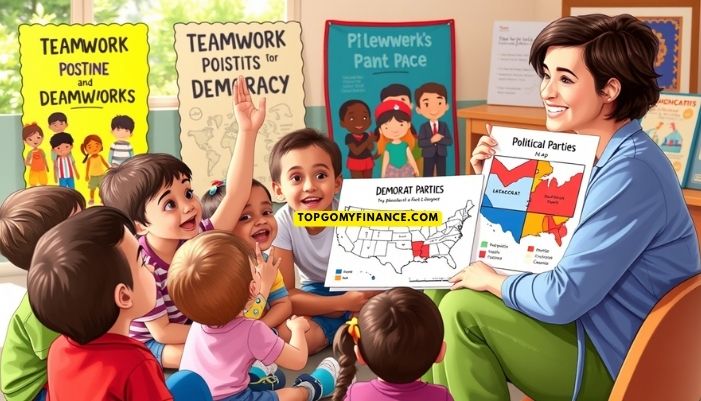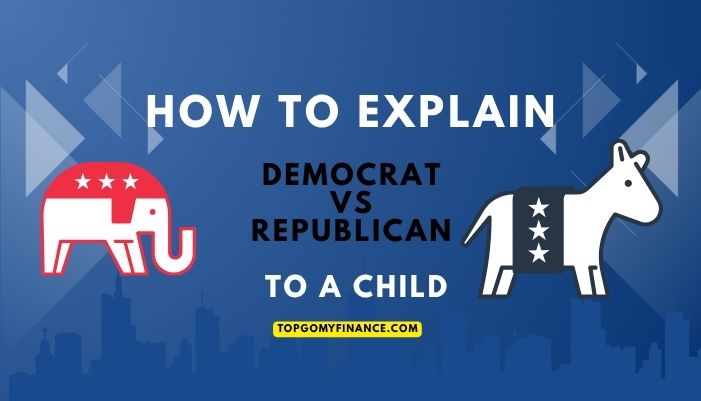Have your kids ever asked what it means to be a Democrat or a Republican?
If they have, you’re not alone. Many parents wonder how to talk about politics in a way that makes sense to kids. The words can sound big, and the topics can seem hard to explain. But don’t worry! You can break it down into simple ideas that kids understand.
This guide will help you explain the difference between Democrats and Republicans in a fun and easy way. You’ll learn how to use stories, real-life examples, and kid-friendly words to help your child understand U.S. politics better.
Let’s keep it simple, honest, and kind.
Why Kids Ask About Politics
Kids are smart. They hear things on the news, see signs during elections, and notice when grown-ups talk about presidents or problems in the world. They want to know what’s going on.
They may ask things like:
- “What’s a Republican?”
- “Who are Democrats?”
- “Why do people fight about it?”
This is your chance to help them learn. If we teach children early, they grow up knowing how to listen, ask questions, and form their own thoughts.

Start Simple: Think of Parties as Two Big Teams
When you explain Democrat vs Republican to a child, try comparing political parties to sports teams or school clubs.
Say something like:
“In our country, we have two big groups. They’re called political parties. Both groups want the country to be safe, happy, and fair. But they have different ideas about how to do that.”
The two main parties are:
- Democrats
- Republicans
You can tell kids that these parties are like teams. They try to solve big problems in different ways. That doesn’t make one better than the other—just different.
Main Differences Between Democrats and Republicans for Kids
Now let’s look at how each party sees some big ideas. Use real-world examples that kids can picture.
1. What Should the Government Do?
Democrats believe the government should help people more, especially those who need extra support.
Republicans think people should do more on their own and that the government should stay smaller.
💬 Kid Example:
Imagine some kids forgot their lunch at school.
- A Democrat might say, “Let’s have the school give free lunch to everyone.”
- A Republican might say, “Let’s help families earn more so they can bring lunch themselves.”
2. Taxes: Who Pays and Why?
Democrats think rich people should pay more taxes so the government can help people who need it.
Republicans believe people should keep more of their own money and decide how to spend it.
💬 Kid Example:
You and your friends are selling lemonade.
- A Democrat might say, “Let’s each give some money to buy cups and napkins for everyone.”
- A Republican might say, “Let each person buy their own things and keep the rest of their money.”
3. Helping People Who Struggle
Democrats want the government to provide things like health care, food, and education to people who don’t have much.
Republicans believe churches, charities, and neighbors can help more than the government.
💬 Kid Example:
If someone is sick or needs help, a Democrat might want the government to pay for their doctor visit. A Republican might want the community to raise money or offer support in other ways.
4. Rules and Freedom
Democrats like to have more rules to keep people safe and protect the environment.
Republicans want fewer rules so people and businesses have more freedom to choose.
💬 Kid Example:
A Democrat might say, “Let’s make a rule that everyone must wear bike helmets.”
A Republican might say, “Let each family decide what’s best for their kids.”
Let Kids Think for Themselves
It’s okay if your child agrees with one side more than the other. What matters most is that they understand both sides and know how to listen and ask questions.
Here’s how you can help:
- Use words they know.
- Keep your voice calm.
- Don’t say one side is “bad” or “wrong.”
- Ask what they think!
It’s not about telling them what to believe. It’s about teaching them to care, think, and learn.
Fun Ways to Teach Kids About Politics
Talking isn’t the only way to teach. You can play, vote, read, and explore ideas together. Here are some fun ideas:
1. Hold a Family Election
Pick a topic everyone cares about—like what to eat for dinner or where to go on the weekend.
- Each person gives a “speech” for their idea.
- Then you all vote.
- Talk about the results together!
This shows how voting works in a simple, fun way.
2. Read Books Together
Books help bring ideas to life. Try books like:
- Grace for President by Kelly DiPucchio
- What Is a Presidential Election? by Douglas Yacka
These books use easy words and fun pictures to explain big topics.
3. Watch Kid-Friendly News
There are news shows made just for kids. Try Time for Kids or News-O-Matic. Watch together and talk about what’s happening.
Ask questions like:
- “What do you think about that?”
- “Why do you think they did that?”
- “What would you do?”
4. Draw or Write About Issues
Kids can draw pictures or write stories about what they would do if they were president. This helps them feel powerful and part of the conversation.
Teaching Kids to Be Kind When They Disagree
Politics can bring up strong feelings. That’s okay. But it’s super important to teach kids how to talk with respect, even when they don’t agree.
Say things like:
- “It’s okay to have different opinions.”
- “Let’s listen before we decide.”
- “We can still be friends even if we vote differently.”
This helps them grow into kind, respectful people who care about others—even if they don’t always agree.
Why It’s Important to Explain Democrat vs Republican to a Child
When kids learn about politics early, they grow up feeling like their voice matters. They’ll know how to:
- Listen to others.
- Speak up for what they believe.
- Work with people who are different from them.
Politics is about solving problems together. And every child can be part of that.
Conclusion
You don’t need to know everything about politics to teach your child. You just need to be honest, open, and kind.
Start simple.
Use real-life examples.
Let them ask questions.
And always remind them: Everyone wants to make the country better—they just have different ideas about how to do it.
With your help, your child can grow into a smart, caring citizen who understands how to work with others and make a difference.











